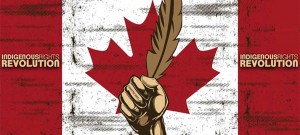The grassroots Idle No More movement is gaining momentum across Canada. In Listuguj, supporters have blocked and slowed highway traffic and set up blockades at the railroad tracks at Pointe-à-la-Croix to prevent freight trains from passing through. The Mi’gmaq Grand Council recently issued a letter in support of the movement, calling on Canada to respect Mi’gmaq Constitutional and treaty rights. This afternoon, the Van Horne bridge will be closed for a peaceful march, and Listuguj Chief Dean Vicaire will travel to Ottawa to meet with Stephen Harper as part of a delegation of First Nations Leaders.
Much of the discussion surrounding Idle No More focuses on the Harper Government’s policies on natural resources––and specifically on Bill C-45. But Montreal-based blogger âpihtawikosisân points out that the movement is about more than land and water rights: it is about the relationship between Canada and Indigenous peoples more generally.
How does language factor in to all of this? In 1951, 87% of Aboriginal people in Canada spoke an Aboriginal languages as their first language. By 1986 this number had dropped to 29% (Burnaby & Beaujot 1986). At current rates of decline, it is predicted that only four of what were once sixty Aboriginal languages spoken in Canada will survive into the next century (UBC 1996).
These languages have not simply fallen out of use. Rather, their decline began in large part with targeted assimilation efforts by the Canadian Government and churches, specifically in the form of Residential Schools. Residential school attendance was mandatory for Aboriginal children between 1884 and 1948, and the last school did not close until 1996. During this period, some 150,000 children were removed from their homes and forced to stop speaking their languages––often at the threat of physical violence. By forcing children to stop speaking their languages, Residential Schools attempted to take away more than just a means of communication:
If you take a language away from its culture, you take away its greetings, its curses, its praises, its laws, its literature, its songs, its riddles, its proverbs, its cures, its wisdom, its prayers. You are losing those things that essentially are the way of life, the way of thought, the way of valuing, and a particular human reality (Fishman 1996).
Though some steps towards reconciliation have been made, a lot of work is still needed to bring these languages back to their communities.
Given the importance of language to cultural identity, it is no surprise that languages have played an important role in indigenous movements worldwide. Across Canada, advances are being made by community-driven language reclamation efforts. This momentum can be seen clearly in Listuguj. In addition to the Mi’gmaq language classes and immersion program being offered at the Listuguj Education Directorate, a number of other community efforts are underway. See the links under “About this project” above to learn more about the Can-8 language-learning software and the new Master-Apprentice Program currently being piloted in Listuguj.


